Introduction to Substrate
How to use the slides - Full screen (new tab)
Introduction to Substrate
Before Going Any Further 🛑
While I speak, please clone polkadot-sdk, and run cargo build && cargo build --release.
About These Lectures and Lecturer
- Ground-up, low-level, but hands-on.
- Intentionally avoiding FRAME, but giving you the tools to be successful at it.
- Narratives above facts all.
- Interrupts and questions are always welcome.
What is Substrate?
Substrate is a Rust framework for building blockchains.
---v
Why Substrate?
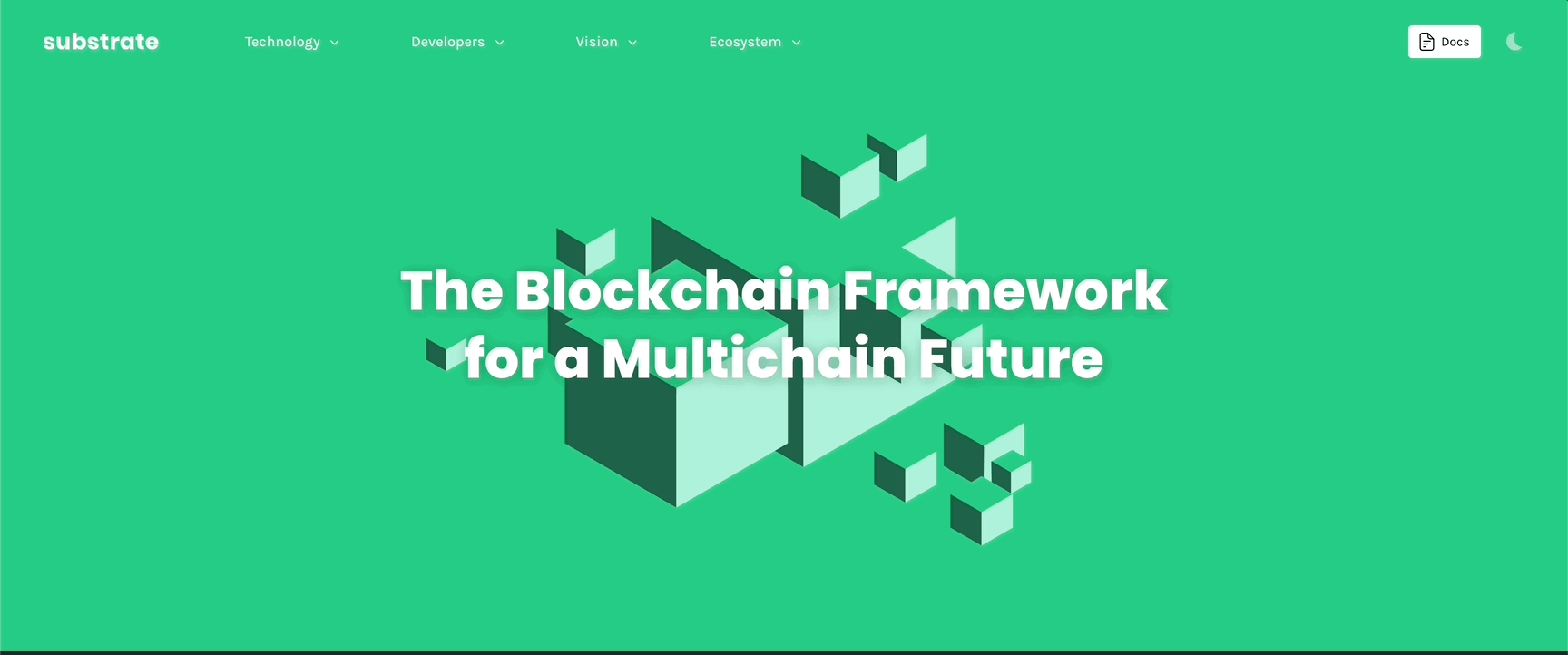
Notes:
Highlight the multi-chain part.
---v
Why Substrate?

Notes:
Polkadot is the biggest bet in this ecosystem against chain maximalism, and Substrate plays a big role in this scenario.
---v
Why Substrate?
- ⛓️ Future is multi-chain.
- 😭 Building a blockchain is hard. Upgrading it even harder.
- 💡 Framework!
- 🧐 But which attitude to take?
Core Philosophies of Substrate 💭
The pre-substrate way of thinking:
- 😭 Building a blockchain is hard. Upgrading it even harder.
- 💪🏻 We are going to spend maximal resources at making sure we get it right.
---v
Core Philosophies of Substrate 💭
But has this worked?
- 😭 Bitcoin block size debate
- 2️⃣ L2s and beyond
- 📈 Ethereum gas price
Notes:
Bitcoin block size has never been and is an ongoing debate.
I am not against L2s per se, but it is true that they mostly exist because the underlying protocol is too hard/slow to upgrade itself. ETH Gas prices also show that the underlying protocol cannot meet the demands of today.
https://en.wikipedia.org/wiki/Bitcoin_scalability_problem https://ycharts.com/indicators/ethereum_average_gas_price
---v
Core Philosophies of Substrate 💭
The Substrate way of thinking:
- ☯️ Society and technology evolve
- 🦸 Humans are fallible
- 🧠 Best decision of today -> mistake of tomorrow
---v
Core Philosophies of Substrate 💭
Outcomes of this:
- 🦀 Rust
- 🤩 Generic, Modular and Extensible Design
- 🏦 Governance + Upgradeability
Notes:
Think about how each of these links back to "whatever you decide today will be a mistake soon".
🦀 Rust
- First line of defense: prevent human error when possible.
- Safe language, no memory safety issues.
Notes:
So at least we don't want to deal with human error, and only deal with the fact that we cannot predict the future.
Memory safety is a fundamental issue in most major system-level programming languages.
Some such mistakes are impossible to make in Rust.
---v
🦀 Rust
int main() {
int* x = malloc(sizeof(int));
*x = 10;
int* y = x;
free(x);
printf("%d\n", *y); // Accessing memory after it's been freed
}
fn main() { let x = Box::new(10); let y = x; println!("{}", *y); // ❌ }
Notes:
another one:
int* foo() {
int x = 10;
return &x;
}
int main() {
int* y = foo();
printf("%d\n", *y); // Accessing memory out of its scope
}
fn foo() -> &'static i32 { let x = 10; &x } fn main() { let y = foo(); println!("{}", y); // ❌ }
---v
🦀 Rust
Microsoft and Google have each stated that software memory safety issues are behind around 70 percent of their vulnerabilities.
Notes:
---v
🦀 Rust
- 🏎️ Most Rust abstractions are zero-cost.
- ⏰ Rust has (almost) no "runtime".
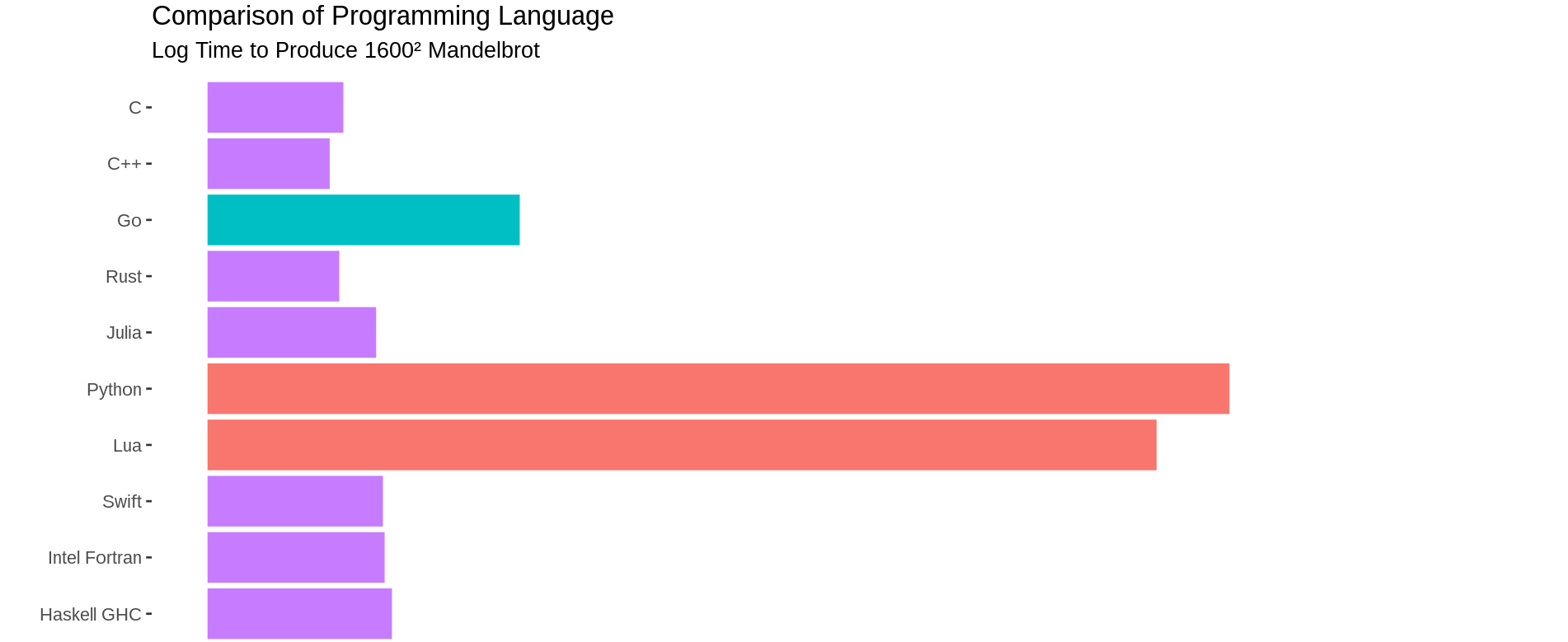
Notes:
this is not 100% accurate though, rust has a small runtime that is the panic handler etc. Rust for
Rustacean's chapter on no_std covers this very well.
Also, this is a good time to talk about how we use "Runtime" in a different way.
🤩 Generic, Modular and Extensible Design
- Second line of defense.
- Our execution (possibly thanks to Rust) is perfect, but we can't predict the future.
Notes:
this is where a module, generic design is useful. You can change components easily based on the needs of the future.
---v
🤩 Generic, Modular and Extensible Design
- Multiple consensus engines (BABE/Grandpa/AURA/PoW/Sassafras)
- Multiple network protocols (QUIC, TCP)
- Multiple database implementations (ParityDB, RocksDB)
- Highly configurable, graph-based transaction-pool.
- Easy to change primitives: AccountId, Signature, BlockNumber, Header, Hash, and many more.
Notes:
FRAME takes this even multiple steps further, but that's for later.
These are all examples of being generic, modular and extensible at the Substrate level. FRAME takes these even further, but more on that later.
---v
🤩 Generic, Modular and Extensible Design
- AlephZero: Custom finality, DAG-based, 1s block time.
- Moonbeam: Ethereum compatible, build with substrate.
- HydraDX: Custom transaction pool logic to match DEX orders.
- Kulupu: Proof of work, custom hashing.
Notes:
Substrate has been coded, from the ground up, such that it is easy to have multiple implementations for certain functions. Heavy use of traits and generics is the key to achieve this. As noted, Substrate has a lot of APIs, and optional implementations. You are bound to the API, but not the particular implementation.
🏦 Governance + Upgradeability
- Third, final, and non-negotiable line of defense to survive the test of time.
---v
🏦 Governance + Upgradeability
- We have correct code, and components are easy to swap, replace, and upgrade.
- What use is that, if we cannot agree on what to replace/upgrade?
- Governance!
- What use is governance, if the upgrade cannot be enacted?
- (trustlessly) Upgradeability!
Notes:
Even if we are governable, but we still need "trust" to enact the upgrade, it is hardly any better. In essence, if an upgrade mechanism is not self-enacting, it might as well just reside offchain and be a signaling mechanism.
---v
🏦 Governance + Upgradeability
- ✅ Governance: Easy
- 😢 Upgradeability: Not so much
---v
🏦 Governance + Upgradeability
- How does a typical blockchain upgrade itself?
Notes:
- Discussion, offchain signaling
- Possibly onchain voting
- Hard(ish) Fork
---v
🏦 Governance + Upgradeability

---v
🏦 Governance + Upgradeability

Notes:
the problem is that the system is one big monolith protocol. Updating any part of it requires the whole thing to be updated.
---v
🏦 Governance + Upgradeability
The way to make a protocol truly upgradeable is to design a meta-protocol that is not upgradeable.
---v
🏦 Governance + Upgradeability

Note:
In this figure, the meta-protocol, the substrate client, is not forklessly upgrade-able. It can only be upgraded with a fork. The Wasm protocol, though, can be upgraded forklessly.
---v
🏦 Governance + Upgradeability

---v
🏦 Governance + Upgradeability
- Fixed meta-protocol?
- "State machine as stored Wasm" in the Substrate client.
- inherently upgradeable protocol?
- Substrate Wasm Runtime
Substrate Architecture

---v
Substrate (simplified) Architecture
Runtime (Protocol)
- Application logic
- Wasm (maybe FRAME)
- Stored as a part of your chain state
- Also known as: STF
Client (Meta-protocol)
- Native Binary
- Executes the Wasm runtime
- Everything else: Database, Networking, Mempool, Consensus..
- Also known as: Host
The Runtime
- Runtime -> Application Logic.
- A fancy term: Runtime -> State Transition Function.
- A technical term: Runtime -> how to execute blocks.
Notes:
- I would personally call the runtime STF to avoid confusion with the "runtime" that is the general programming runtime, but kinda too late for that now.
- Among the definitions of the Wasm runtime, let's recap what the state transition is.
- The block execution definition will be described more in the Wasm-meta lecture.
State Transition Function
State

Notes:
entire set of data upon which we want to maintain a consensus. key value. associated with each block.
---v
State Transition Function
Transition Function

---v
State Transition Function
$$STF = F(block_{N}, state_{N}, code_{N}): state_{N+1}$$
---v
State Transition Function

Notes:
The Wasm runtime in this figure is in fact obtained from the state (see 0x123)
---v
State Transition Function

---v
State Transition Function

Notes:
THIS IS HOW A META-PROTOCOL MAKES A SYSTEM UPGRADE-ABLE.
could we have updated the code in N+1? By default, no because we load the wasm before you even look into the block.
IMPORTANT: State is not IN THE BLOCK, each state has AN ASSOCIATED BLOCK.
Keeping the state is 100% optional. You can always re-create the state of block N by re-executing
block [0, .., N-1].
ofc, changing the Wasm code cannot be done by anyone. That's up to governance.
Full Substrate Architecture

Positive Consequences of Wasm Runtime 🔥
---v
🤖 Deterministic Execution
- Portable, yet deterministic.
Notes:
Wasm's instruction set is deterministic, so all good.
---v
🧱 Sandboxing
- Useful when executing untrusted code.
- Smart contracts
- Parachain runtime
Notes:
How can we guarantee that neither enter an infinite loop, or try to access the filesystem?
---v
🌈 Easier (light)Client Development
Notes:
for the case of client, your client only needs to implement a set of host environments, and NOT re-implement the business logic.
Simply compare the process to create an alternative client for Ethereum, where you need to re-implement the EVM.
Same applies to light client, as they do not need to deal with the state transition function.
---v
😎 Forkless Upgrade

---v
😎 Forkless Upgrade

---v
😎 Forkless Upgrade
This update was:
- Forkless
- Self-enacting
Notes:
take a moment to establish that this upgrade is forkless. The runtime is upgraded, but the client is not. In fact, the client didn't need to know about this at all.
This is what the meta-protocol achieves.
Negative Consequences of Wasm Runtime
- 😩 Constrained resources (memory, speed, host access).
- 🌈 Client diversification != state-transition diversification
Notes:
- 4GB of memory, which we limit even further.
- Wasm has no allocator+panic handler of its own
- Can be slower than native, depending on the executor/execution method.
- Limited access to the host host env, all needs to be done through syscalls.
Less state-transition diversification, because the runtime is the same for all clients. If there is a bug in it, everyone is affected.
Consensus <> Runtime 🤔
- Yes, consensus is not a core part of a blockchain runtime. Why?
- Not part of your STF!
- The consensus protocol is to your runtime what HTTP is to Facebook.
Notes:
comments from Joshy:
I think this is important. The runtime is the application you want to run.
Consensus is outside of this application helping us agree what the official state of this runtime is. Last wave I used this analogy.
Imagine a writers room for some TV show. Writers are sitting around coming up with potential plot points for future episodes. Any of their ideas could work. But eventually they need to agree what the next episode to air actually will be.
Database <> State 🤔
- State is the entire set of key value data that is associated with one block.
- Database is the component that allows this be stored in disk. May or may not be key-value.

Notes:
State is sometimes called "storage" as well.
Database <> Runtime 🤔
- Yes, data is stored outside of the runtime. Why?
- Wasm runtime does not have the means to store it.
- Yet, the interpretation of the data is up to the runtime.
---v
Database <> Runtime 🤔

---v
The Client: Database 🤔
- The database, from the client's PoV, is an untyped, key-value storage.
- The runtime knows which key/value means what.
State of Light Clients
- Client that follows headers, therefore knows state roots and can ask for state-proofs to do more.
---v
State of Light Clients
- Not only possible, but they can also run as Wasm, in the browser!
- "Substrate Connect" / SMOLDOT

Notes:
What was a light client? follows only block headers, therefore knows state roots, and a few other pieces of information, others send it state proofs if it wishes to do more.
SMOLDOT is not exactly a substrate client. It is mainly designed to work with Polkadot. But with minimal tweaks, you could make it work for more substrate based chains.
This has to do with the fact that consensus and a few other bits of the client and runtime are not 100% independent. For example, GRANDPA has a pallet on the runtime side, but is mostly in the client. Now, a client that is configured with GRANDPA can only work with runtimes that are also configured with GRANDPA.
Communication Paths

---v
Communication Paths

---v
Example: SCALE vs JSON
- SCALE is an efficient, non-descriptive, binary encoding format, used EXTENSIVELY in the Substrate ecosystem.
---v
Example: SCALE vs JSON
use parity_scale_codec::{Encode}; #[derive(Encode)] struct Example { number: u8, is_cool: bool, optional: Option<u32>, } fn main() { let my_struct = Example { number: 42, is_cool: true, optional: Some(69), }; println!("{:?}", my_struct.encode()); // [42, 1, 1, 69, 0, 0, 0] println!("{:?}", my_struct.encode().len()); // 7 }
---v
Example: SCALE vs JSON
use serde::{Serialize}; #[derive(Serialize)] struct Example { number: u8, is_cool: bool, optional: Option<u32>, } fn main() { let my_struct = Example { number: 42, is_cool: true, optional: Some(69), }; println!("{:?}", serde_json::to_string(&my_struct).unwrap()); // "{\"number\":42,\"is_cool\":true,\"optional\":69}" println!("{:?}", serde_json::to_string(&my_struct).unwrap().len()); // 42 }
Substrate and Polkadot

Substrate and Smart Contracts

---v
Substrate and Smart Contracts
A Substrate-Connect extension is syncing a chain who's runtime is executing wasm contracts.
Question: How many nested Wasm blobs are executing one another?
---v
Substrate and Smart Contracts

- The browser is executing:
- a Wasm blob (substrate-connect)
- that executes a Wasm blob (runtime)
- that executes a Wasm blob (contract)
---v
Substrate and Smart Contracts
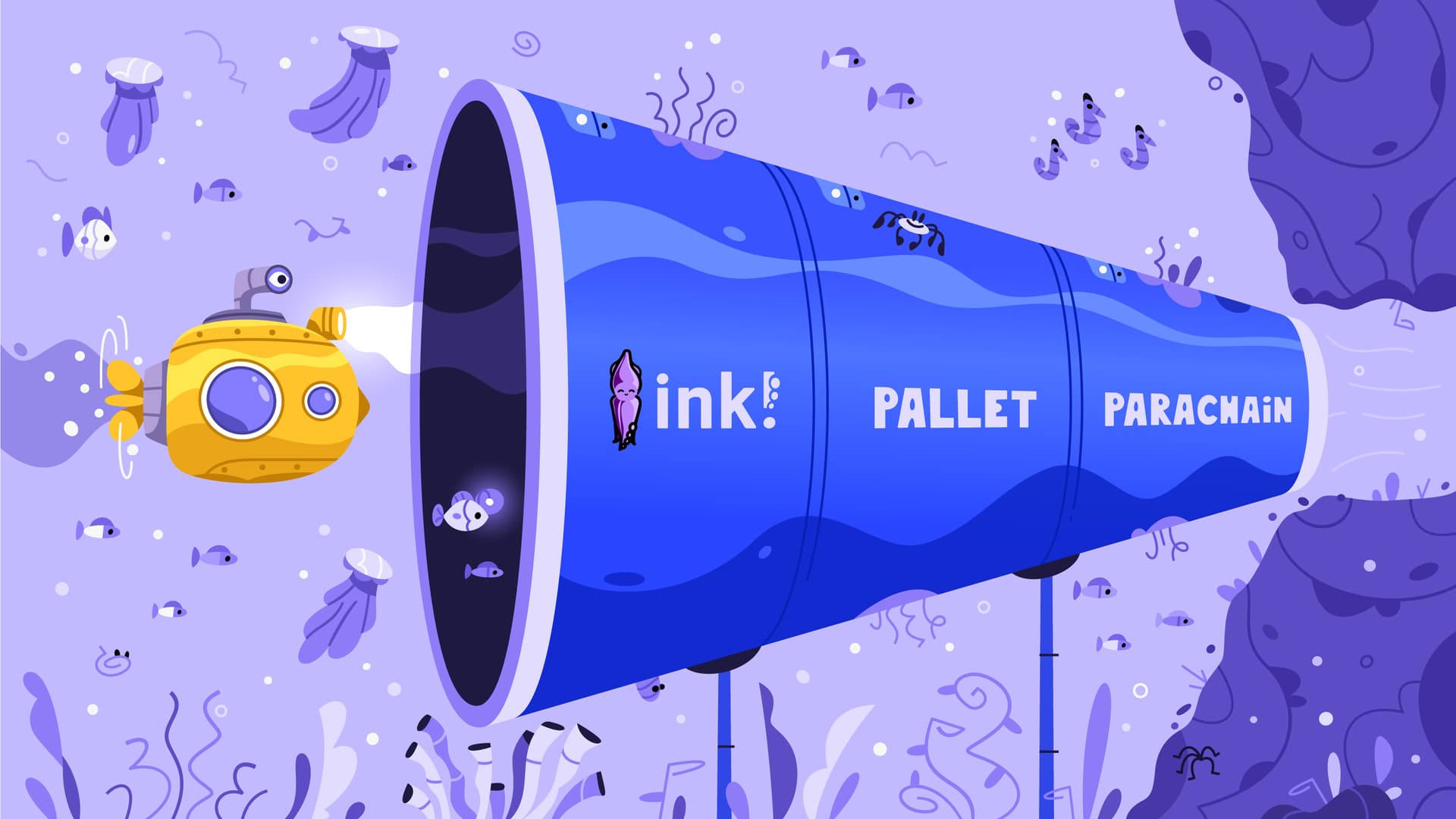
---v
Substrate and Smart Contracts
- So when should you write with a smart contract (Ink!) and when a Runtime (FRAME)?
Notes:
I was asked this yesterday as well. My latest answer is: if you don't need any of the customizations that a blockchain client/runtime gives to you, and the performance of a shared platform is okay for you, then go with a smart contract. If you need more, you need a "runtime" (some kind of chian, parachain or solo)
An example of customization is that a runtime has access to on_initialize etc.
Also, a contract can not have fee-less transactions.
Also, a contract usually depends on a token for gas, while a runtime can be in principle token-less fee-less.
Technical Freedom vs Ease

Substrate: The Gaming Console of Blockchains!
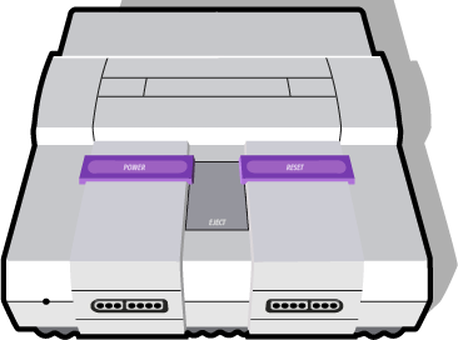
Substrate Client
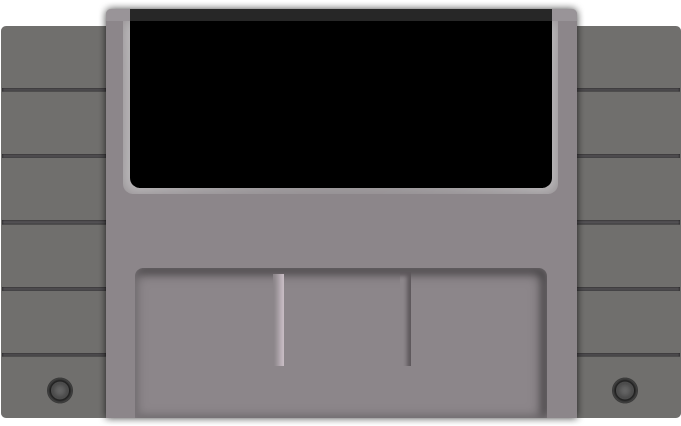
Substrate's Wasm Runtime
Notes:
Another good analogy: Client is the FPGA, and FRAME/Wasm is the VHDL.
Lecture Recap
- Substrate's design stems from 3 core principles:
- Rust, Generic Design, Upgradeability/Governance
- Client / Runtime architecture
- State Transition
- Positive and negative consequences of Wasm
- Substrate next to Polkadot and other chains.
- Substrate for Smart Contracts.
---v
Recap: Substrate Architecture

---v
Recap: 🏦 Governance and Upgradeability
A timeless system must be:
- Generic
- Governable
- Trust-less-ly Upgradeable.
Substrate's Wasm meta-protocol exactly enables the latest ✅
Notes:
Question: how would you put the meta-protocol of Substrate into words?
The client is basically a wasm meta-protocol that does only one thing. This meta-protocol is hardcoded, but the protocol itself is flexible.
Rest of This Module! 😈
Track: Main Lectures
- Wasm Meta Protocol
- Substrate Storage
Track: Aux Lecture
- TX-Pool
- Substrate: Show Me The Code
- Substrate Interactions
- SCALE
Track: Graded Activity
- FRAME-Less
---v
Rest of This Module! 😈
Day 0
- Introduction ✅ (60m)
- Wasm Meta Protocol (120+m)
- Activity: Finding Runtime APIs and Host Functions in Substrate
- 🌭 Lunch Break
- Show Me The Code (60m)
- Substrate Interactions (60m)
- FRAME-Less Activity (60m)
Notes:
We are aware that the module is highly skewed in terms of lecture time, but it is intentional and we want to see how it works. This allows you to kickstart with your assignment earlier.
---v
Rest of This Module! 😈
Day 1
- Transaction Pool (60m)
- SCALE (60m)
- Substrate/FRAME Tips and Tricks
- 🌭 Lunch Break
- FRAME-Less Activity
---v
Rest of This Module! 😈
Day 2
- Substrate Storage (90m)
- FRAME-Less Activity
- 🌭 Lunch Break
- End of Module 🎉
Additional Resources! 😋
Check speaker notes (click "s" 😉)

Notes:
-
Great documentation about all things substrate/blockchain from smoldot: https://docs.rs/smoldot/latest/smoldot/
-
Read more about why we use Rust at Parity: https://www.parity.io/blog/why-rust/
-
An interesting question on JVM/Wasm: https://stackoverflow.com/questions/58131892/why-the-jvm-cannot-be-used-in-place-of-webassembly
-
Rust safety: https://stanford-cs242.github.io/f18/lectures/05-1-rust-memory-safety.html
-
https://www.reddit.com/r/rust/comments/5y3cxb/how_many_security_exploits_would_rust_prevent/
-
The substrate clients should still have some level of determinism in their performance. If authority nodes have extremely varied performances, they could start finalizing different forks.
-
There have been attempts at writing FRAME alternatives, namely AssemblyScript. https://github.com/LimeChain/as-substrate-runtime
-
Think about the differences between a runtime and a smart contract.
- A runtime is in some sense a smart contract as well, but not a user-deployed one.
- https://en.wikipedia.org/wiki/Smart_contract
- https://www.futurelearn.com/info/courses/defi-exploring-decentralised-finance-with-blockchain-technologies/0/steps/251885#:~:text=to%20the%201990s.-,Writing%20in%201994%2C%20the%20computer%20scientist%20Nick%20Szabo%20defined%20a,of%20artificial%20intelligence%20is%20implied.
-
Substrate Primitives (
sp-*), Frame (frame-*) and the pallets (pallets-*), binaries (/bin) and all other utilities are licensed under Apache 2.0.
Substrate Client (/client/* / sc-*) is licensed under GPL v3.0 with a classpath linking exception.
-
Apache2 allows teams full freedom over what and how they release, and giving licensing clarity to commercial teams.
-
GPL3 ensures any deeper improvements made to Substrate's core logic (e.g. Substrate's internal consensus, crypto or database code) to be contributed back so everyone can benefit.
-
Currently, the Wasm binary spec v1 is used, read more about the new version here: https://webassembly.github.io/spec/core/binary/index.html
Post Lecture Feedback
- a takeaway after each section, more clear path (shawn).
Appendix: What is Wasm Anyways?
WebAssembly (abbreviated Wasm) is a binary instruction format for a stack-based virtual machine. Wasm is designed as a portable compilation target for programming languages, enabling deployment on the web for client and server applications.
---v
What is Wasm Anyways?

---v
What is Wasm Anyways?
- Wasm ❤️ Web
- Streaming and rapid compilation.
- Designed with the concept of host in mind. Sandboxed, permissioned sys-calls.
Anyone remember "Java Applets"?

Notes:
People actually tried sticking things like JVM into the browser (Java Applets), but it didn't work.
---v
How to Write a Wasm Runtime?
- Any language that can compile to Wasm and exposes a fixed set of functions, to be used by the client.
- ... But, of course, Substrate comes with a framework to make this developer-friendly, FRAME™️.
Appendix: More Diagrams of Substrate and Polkadot
Notes:
I made these figures recently to explain the relationship between Substrate, Cumulus and Polkadot. They use the most generic term for client and runtime, namely "Host" and "STF" respectively.
---v
Substrate

---v
Polkadot
 ---v
---v
A Parachain
